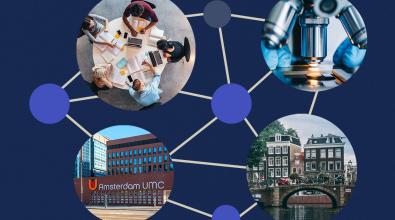 Read More
Read More
What we can learn from Mexico City about digital transformation

Mexico City’s then-Mayor Claudia Sheinbaum (center) made digital innovation a priority of her administration when she was elected in 2018. Photo: Associated Press
When Claudia Sheinbaum was elected mayor of Mexico City, she came to office with a clear mission in mind: Make this city of nearly 10 million people a place defined by fairness and innovation. She also understood that the digital transformation of city services was the best way she could ensure that all residents—from the most vulnerable to the most advantaged—had efficient access to the health care, personal records, and government programs they were entitled to.
Sheinbaum’s team quickly launched a Digital Agency for Public Innovation, consolidating all of the city’s digital transformation-focused talent, strategies, and efforts under one roof. Then, first on its own and more recently with the aid of a Bloomberg Philanthropies-funded innovation team (i-team), the city set about tackling issues of urgent concern to low-income residents, from providing basic information on public transit to offering a digital option for renewing driver’s licenses. Within the span of only a few years, Mexico City had created an online option for roughly 75 percent of interactions between residents and the government and built one of the world’s largest, free, city-provided WiFi networks to ensure residents can access those services.
While not all cities have the resources or the technological know-how to be so ambitious, Mexico City’s experience—as recently highlighted at Bloomberg CityLab and in a report this fall by Harvard’s Data-Smart City Solutions—holds lessons for every city looking to level up its digital offerings. They include:
- Make the most of your team by running a nimble, project-based operation.
- Target use of tech at specific, urgent problems—and release solutions quickly.
- Make offerings inclusive, and take them beyond pure technology.
- Turn data into insights to guide action and build political support.
Make the most of your team by running a nimble, project-based operation.
In Mexico City, an early priority was creating a cohesive digital agenda to serve a massive population experiencing significant poverty—and developing a single agency that could oversee that work. That meant first creating a clear vision for the Digital Agency for Public Innovation (ADIP) and an organizational structure that aimed to reduce waste. The agency then hired a sizable staff to pursue an agenda defined by autonomy: using outside vendors as little as possible. The savings—from consolidating the agenda and the reduced reliance on vendors—allowed the government to think bigger and, ultimately, move product development in-house.
“One of the main things is…using public money for public welfare, not for bureaucracy, not for multi-billion private contracts,” explains ADIP founder and head José Merino.
The agency also applies what Stephen Goldsmith and Christina Nagler—co-authors of the Harvard report on Merino and his colleagues’ work—describe as “project management discipline” to initiatives. In other words, they employ product development practices proven to work in the private sector. This means establishing concrete timelines for development and clearly assigning responsibility to all stakeholders.
This approach helped unlock ADIP’s massive potential. The agency’s signature offering is an impressive one: a single centralized sign-on, called “Llave” (or “Key” in Spanish), and a single app that consolidated dozens of others and provides residents digital access to the vast majority of city services.
While not every city has this kind of budget or manpower, the principles applied in Mexico City—especially around autonomy and the essential nature of digital services—are widely applicable, according to Jennifer Pahlka, founder of Code for America, former deputy chief technology officer in the Obama administration, and Merino’s co-panelist at CityLab. She advises that cities that don’t have the capacity to develop digital products in house instead focus on developing enough know-how to hold vendors accountable.
“Think about: What are the core capabilities and capacities that you do need to have in-house in order to have a healthy vendor ecosystem? And be in control of your own destiny,” she said. That way, if the situation changes—if residents’ needs change—city leaders can ensure digital services change, too.
Target use of tech at specific, urgent problems—and release solutions quickly.
One way to create the conditions for courageous and ambitious digital capacity is to start small, focusing on relatively modest, tangible wins. Merino sums up this approach with the acronym KISS, or keep it simple, and then scale. “We started with one service, and we added a second one, and then a third one,” he says. The idea here is to build credibility both internally and externally as quickly as possible with straightforward products that can be used by a wide swath of the population. If those products have to be revised and updated, so be it—the main goal is to establish value promptly.
As Goldsmith and Nagler write, “In 2019, ADIP delivered a new product every three days. The team identified obvious, easily tackled obstacles, and developed solutions, proving ADIP’s impact and building a reputation based on results.”
The services have included basic necessities like vehicle registration, ensuring their work is felt by people across the income spectrum and especially by lower-income people. Any city—even those that contract with vendors—can aim for a relatively small menu of early wins on digitization that will resonate widely. And in keeping with the KISS model, sharing their information on Llave once allows citizens to use the same credentials for additional services.
Make offerings inclusive, and take them beyond pure technology.
The digital transformation in Mexico City wasn’t just about digitizing processes or building apps; it also called for partnering with legal and other authorities to simplify bureaucracy and better meet the needs of residents who had come to expect too little from their government. At one point, Merino says, copies of birth certificates in Mexico City expired three months after they were issued. So resolving the problem wasn’t just a technology matter, but an administrative one—and required changing regulations to set the stage for greater innovation across government.
A successful digital approach often starts with simply ensuring residents can access applications to use as intended. One tactic Mexico City used was rolling out a free WiFI initiative—and even subsidizing data plans when WiFi was not available—so citizens could actually reach its offerings. Another was making sure digital products worked on almost any phone a citizen might own, with the agency using the lowest-level smartphones sold at convenience stores as a proxy for success.
What united these approaches was a mission-driven culture that was committed to equity. As Sheinbaum once explained, “Technology does not make sense if it isn’t for the benefit of the inhabitants, especially the most marginalized of our city.”
Turn data into insights to guide action and build political support.
In Mexico City, the number of users on the Llave platform has topped six million, equivalent to roughly 87 percent of the adult population in the city proper. The agency has rolled out more than 330 products in less than five years, with a market value of $100 million. And with Llave fast-tracking the sharing of resident information between departments, the agency has consolidated some 2,100 procedures down to roughly 500 in a massive streamlining of the process of engaging with the local government.
Among the examples cited by Merino was getting street lights fixed. A previous system required residents to call a phone number, file a report, wait for someone from the city to confirm the issue, wait for the city to send someone to fix it, and then wait for yet another person to confirm it was working. Now, he says, a 311-style system is one of the most-used services under the system’s digital infrastructure, and residents get notifications that things they requested are being addressed—and are given the opportunity to reopen the issue if need be.
But it goes beyond just showing results. There needs to be trust that the result was worthwhile. That's where demonstrating efficiency, cost-effectiveness, and care as custodians of taxpayer dollars comes into play. As Goldsmith and Nagler explain, the agency used $25,000—the amount the government estimated it would cost to rebuild a home after an earthquake—as a metric for spending. The idea was that every investment by the digital agency at that level should deliver public good at the same value as a person’s home. So if the agency is putting $500,000 into a new product, will it offer the public as much of a return collectively as building 20 new homes would?
Finally, while there’s a public-facing component, there’s also an internal need to showcase successes and build a culture of respect for digital services. Ideally, political leaders may not only be on board with digitization, but able to talk about it and use it themselves. Merino says that then-Mayor Sheinbaum—who was asked about her city’s efforts at CityLab in 2022 and is now a leading candidate to be the next president of Mexico—was vital to its success.
“She always placed the agency in the center of government decisions,” he says. “We were called into every single meeting—always. It was very obvious to everyone that we were a relevant player, so they paid attention to us.”

